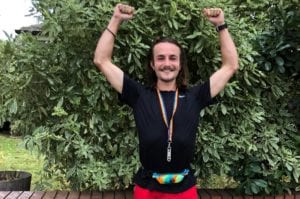This audio was created using Microsoft Azure Speech Services
Part 2: Learning the lessons
This blog series is about training for a marathon and how a less-than-athletic, self-proclaimed sustainability & intelligent energy evangelist relates energy waste to sore limbs.
I’ve never run a marathon and, until several months ago, the thought of running one never entered my mind. My attitude towards running was quite simple: Run only if being chased! So I’ve evolved in my thinking (mostly) and am in the midst of training for the 2014 Schneider Electric Marathon de Paris. In my first post of this series, I discussed how some early painful experiences motivated me to consult with experts on how to avoid killing myself. I needed to be shown how to make the experience both effective and safe. Since then the kilometers have been adding up, my pain levels are down (somewhat), and I’ve had some time to reflect on some key lessons I’ve learned.
Lesson #1 – What you wear matters!
Most of my practice runs have been in the Pacific Northwest. I started in October and that means cold, wet runs. I started by wearing some regular bright-colored cotton “gym” clothes. I figured, if I’m going to suffer somewhat, I might as well do so in style and see if I can’t turn a few young female heads my way (I’m single, male, and in my late 20’s which indicates why I allow this mentality to influence my decisions).
I thought my sweat shirt, cotton t-shirt and toque would suffice, but after those first several 10 km runs though drizzly, moss filled forests, the clothes I was wearing only absorbed my sweat which resulted in what felt like my upper body being wrapped in a damp, cold towel. (Plus, no women paid any attention to me at all!) This was no good and I quickly developed a cold which stunted my training for several days. 
Since then, I’ve acquired polyester & wool running shirts which are a big change from my archaic days wearing cotton. Polyester and wool are very efficient at wicking moisture from the inside to the outside where it evaporates; in turn I’m not running with a chilled upper body – great for Vancouver Island winters. No girls yet, but no colds either!
Lesson #2 – Be flexible enough to allow for adjustments
In November, I headed south to Mexico for some rest and relaxation – from work, not marathon training. Gone were the grey, windy winters on the west coast of Canada. However, my initial run south of the border was a scorcher. At the 7km mark, I quickly developed a sharp, cramping pain in my right calf muscle – it literally felt like someone had hit my right leg with a spiked club. It was then I realized that my priorities should no longer be focused on avoiding a chill, but rather to keep hydrated while running under the Mexican sun. I had to drink plenty of water before and after my runs in addition to bringing water with me to avoid future cramping. I also discovered that potassium and various electrolyte powders would help keep me with hydrated in the tropical environment.
Lesson #3 – Measure your progress
The level of pain (or lack thereof) is not the only means of measuring whether you’re improving or not. Lots of cool technology is available to runners for measuring calories burned, heart rate, distances run, and pace. These technologies help to serve as a guide and facilitator, almost like a virtual coach.
How the marathon “technology” lessons apply to business
When running a marathon, clothing, shoes, temperature control and monitoring devices all make a big impact on overall performance. I work with Schneider Electric and we are experts in energy management and business efficiency. We work with organizations large and small in multiple regions around the world as well as facilitate many conversations about energy consumption and CO2 emissions. One initial topic of conversation is the geographical location of facilities. This has many implications on manufacturing costs, supply chain efficiency, and societal obligations. If a geographical location is prone to certain extreme or unpredictable weather conditions, we advise on infrastructure needed to cost-effectively endure such changes. Or if the locale qualifies for energy management tax incentives, we provide strategies on how to capitalize.
Both on the business side and on the marathon side, there are many technological solutions available to address the multitude of barriers that every runner or energy consumer faces. In the same way that appropriate clothing and running equipment can make running in various geographies doable and more enjoyable, a comprehensive approach to energy management involves the right tools and processes for monitoring and optimal performance. If you don’t know where to start, there are multiple on-line energy management and sustainability forums and areas where you can connect with other people looking to discus similar topics. And if you’re a bit further down the energy efficiency journey, there are even portals that are set-up to foster specific projects with large energy consumers, partners and solution vendors.
At the end of the day it all comes down to people interacting and having constructive dialogue around a common experience that will not only address the task at hand, but will also provide valuable insight that will help address future encounters.
Schneider Electric is this year’s sponsor of the Marathon de Paris, a world class race with over 40,000 runners that will take place on April 6, 2014.
Want to know how the marathon went? Check out part 3, Marathons and Energy Conservation: Never Underestimate the Power of the Collective Human Will
In this blog series, I will share some of my personal experiences in preparation for this momentous event. I will also be sharing some juicy tidbits on what “intelligent energy” really means and how best practices can really help to save you money. This blog series can be found by searching “#ParisMarathon2014” in the search field (top right of the blog site) or by looking up ‘Nick Blandford’ in the bloggers directory to discover all blog posts I’ve published including this series. I can be found on twitter (@nickblandford) and most of my training runs have been recorded under ‘Nick Blandford / Victoria BC’ on Strava, which is a free app that lets you track your runs via a mobile device and helps you analyze and quantify your performance.
Are you going to be at the Marathon de Paris? Have you trained for a marathon? Feel free to share your experiences below.



